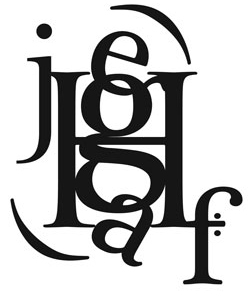Prose from Poetry Magazine
Visual Poetry Today
They are not merely poems, but they are certainly poems.
BY Geof Huth
Introduction
"The child of both poetry and the visual arts, visual poetry has a double set of interests and its forms are myriad. We are living through what might be the greatest age of visual poetry."

The original forms of visual poetry—the technopaegnia of classical times and the pattern poetry of the 1500s and beyond—were easier to define. Their hybridization consisted merely of giving conventional poems an essential visual structure. A good example would be George Herbert's "Easter Wings," a masterwork of visual poetry written in the shape of angels' wings. Designed to be printed with its words running sideways down the page, the poem is heavily metrical, rhymes, and takes advantage of varying line lengths to concentrate its verbal message. It is not merely a poem, but it certainly is a poem.
Few visual poems these days function as poems do. Instead, they encompass a wide range of verbo-visual creations that focus on the textual materiality of language. The form includes poems written as mathematical equations, collage poems, xerographic pieces that include no words but concentrate on the meaning that has built up within the shapes of letters, and even asemic writings in invented scripts created to mean through shape rather than word. Visual poetry is written for the eye, but its methods and intentions, even in those works most limited in their verbal content, are always poetic, always compelling the reader forward into the transformative power of language, always entranced by—and entrancing through—the text that is before us.
Visual poetry provides a reading challenge to most readers, because the methods of interpreting information vary widely. Some poems read linearly, just as a traditional poem would. Many others utilize individual words outside of any traditional syntax, requiring the reader to find connections that are suggested only spatially. Most contemporary visual poems fragment words into pieces, forcing the reader to delve ever more deeply into the text to sift meaning out of an often hectic mise-en-page. One important notion to keep in mind while reading visual poetry is that it makes sense via more than just the text itself. Color, shape, and arrangement—including proximity to, and integration with, images—are important elements in the meaning of any visual poem.
We are living through what might be the greatest age of visual poetry, in a time when the methods of production and distribution are such that the form can prosper without the need for extensive capital. A convergence of factors—which include the Internet, print-on-demand publishing, and an increasing interest in the visual and textual—has allowed this hybrid form to flourish across the planet. Visual poetry used to be confined to mimeographed or photocopied magazines that rarely existed in editions greater than one hundred. Today, many venues on the Internet, including poetry e-zines, regularly publish visual poetry, making access effectively free, and distribution essentially infinite.
This portfolio of twelve works provides only a hint to the richness and variety of today's visual poetry. Without a selection much larger than this, it is impossible to represent the constant inventiveness of today's visual poets. The pieces here include works from three different countries. Some of these poets have been working in the form for decades. Others are relative newcomers. These twelve pieces by these thirteen people represent the smallest slice of their work and an even smaller one of the world of visual poetry, but together they provide an instructive glimpse at an entire world of creation.—GH
| AUTHOR | TITLE | |
 | mIEKAL aND | mi'kmaq book of the dead |
| K. S. Ernst & Sheila E. Murphy | Vortextique | |
 | derek beaulieu | untitled (for Natalee and Jeremy) |
 | Peter Ciccariello | The Disremembered Glossolalist |
 | Bob Dahlquist | alwaysendeavor |
 | Jesse Patrick Ferguson | Mama |
 | Scott Helmes | haiku #62 |
 | Joel Lipman | from “Origins of Poetry” |
 | gustave morin | toon tune |
 | jörg piringer | fallen |
 | Philip Gallo | untitled |
 | Michael Basinski | Labile |
Geof Huth is a poet and visual poet who writes daily on visual poetry and related matters at dbqp.blogspot.com. His recent books are Out of Character (Paper Kite Press, 2008), Longfellow Memoranda (Otoliths, 2008), and texistence (co-written with mIEKAL aND, from Xexox Sutra Editions, 2008.
Read Full Biography 

